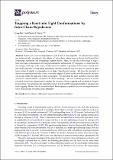Trapping a Knot into Tight Conformations by Intra-Chain Repulsions
Author(s)
Dai, Liang; Doyle, Patrick S
DownloadDai-2017-Trapping a Knot into Tight Conformati.pdf (8.497Mb)
PUBLISHER_CC
Publisher with Creative Commons License
Creative Commons Attribution
Terms of use
Metadata
Show full item recordAbstract
Knots can occur in biopolymers such as DNA and peptides. In our previous study, we systematically investigated the effects of intra-chain interactions on knots and found that long-range repulsions can surprisingly tighten knots. Here, we use this knowledge to trap a knot into tight conformations in Langevin dynamics simulations. By trapping, we mean that the free energy landscape with respect to the knot size exhibits a potential well around a small knot size in the presence of long-range repulsions, and this potential can well lead to long-lived tight knots when its depth is comparable to or larger than thermal energy. We tune the strength of intra-chain repulsion such that a knot is weakly trapped. Driven by thermal fluctuations, the knot can escape from the trap and is then re-trapped. We find that the knot switches between tight and loose conformations—referred to as “knot breathing”. We use a Yukawa potential to model screened electrostatic interactions to explore the relevance of knot trapping and breathing in charged biopolymers. We determine the minimal screened length and the minimal strength of repulsion for knot trapping. We find that Coulomb-induced knot trapping is possible to occur in single-stranded DNA and peptides for normal ionic strengths.
Date issued
2017-02Department
Massachusetts Institute of Technology. Department of Chemical Engineering; Singapore-MIT Alliance in Research and Technology (SMART)Journal
Polymers
Publisher
MDPI AG
Citation
Dai, Liang and Doyle, Patrick. “Trapping a Knot into Tight Conformations by Intra-Chain Repulsions.” Polymers 9, no. 2 (February 2017): 57 © 2017 by the authors
Version: Final published version
ISSN
2073-4360